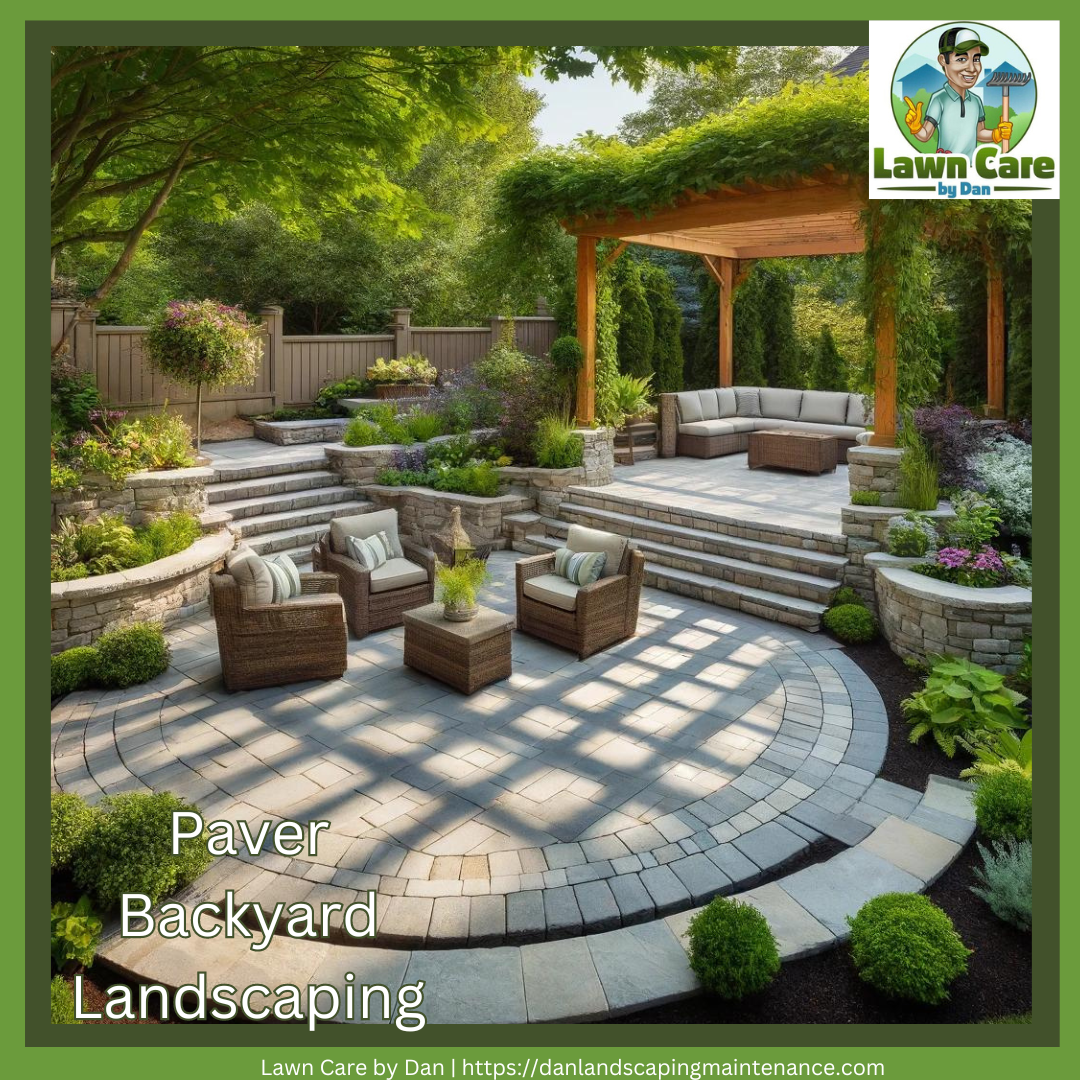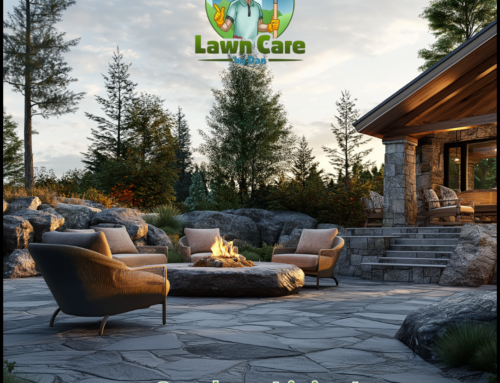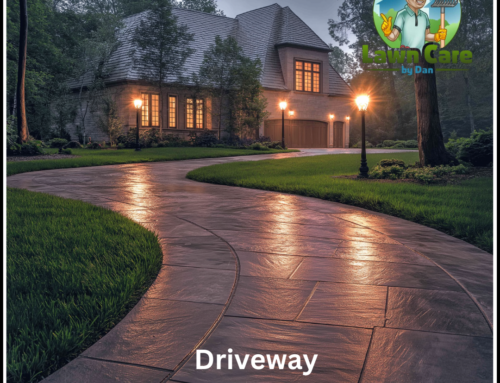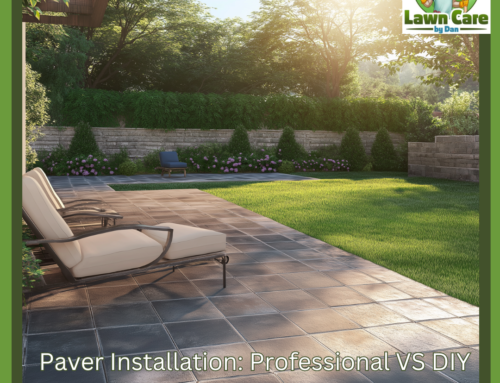
Transforming your backyard can seem daunting, especially when choosing the right pavers. Fear not! Lawn Care by Dan is here to guide you through the process, ensuring your outdoor space becomes a stunning retreat. Whether you want to create a cozy patio, a winding garden path, or a robust driveway, this guide will walk you through the essential steps.
Creating the perfect outdoor space starts with the right foundation, and pavers are an excellent choice for various landscaping projects. This guide will help you navigate the selection process, from understanding the different types of pavers to installation and maintenance. By the end of this article, you’ll be equipped with the knowledge to make informed decisions and transform your backyard into an inviting haven.
Understanding Pavers
Pavers are versatile and durable materials that create hard surfaces in outdoor areas. They come in various shapes, sizes, and materials, each offering unique aesthetic and functional benefits. Whether creating a patio, driveway, walkway, or pool deck, understanding the types of pavers available and their advantages can help you make an informed decision. Let’s delve deeper into the common types of pavers and their distinct characteristics so you can confidently choose the best one for your project.
Types of Pavers
Concrete Pavers
Concrete pavers are homeowners’ most popular choices due to their affordability and versatility. They are made from cement, sand, gravel, and water and molded into various shapes and sizes. This affordability ensures you can create your dream outdoor space without breaking the bank.
Advantages:
- Cost-Effective: Concrete pavers are less expensive than natural stone or brick ones.
- Variety: Available in numerous styles, colors, and finishes, allowing various design possibilities.
- Strength: They are durable and can withstand heavy loads, making them suitable for driveways and high-traffic areas.
- Ease of Installation: Concrete pavers are relatively easy to install and replace, which can save on labor costs.
Disadvantages:
- Color Fading: Over time, the color of concrete pavers can fade due to exposure to sunlight and weather conditions.
- Maintenance: They may require regular sealing to maintain their appearance and prevent staining.
Brick Pavers
Brick pavers are made from clay that is formed into shape and then cured through a heating process. They offer a classic, timeless look that can enhance the aesthetic appeal of any outdoor space.
Advantages:
- Aesthetic Appeal: Brick pavers, with their natural earth tones and traditional appearance, provide a warm, inviting look.
- Durability: Highly durable and resistant to cracking, making them ideal for areas with heavy foot traffic.
- Eco-Friendly: Made from natural materials and can be recycled, contributing to environmental sustainability.
- Low Maintenance: Requires minimal maintenance and can last for decades with proper care.
Disadvantages:
- Cost: Generally, it is more expensive than concrete pavers due to the manufacturing process.
- Limited Color Options: Brick pavers come in fewer colors than concrete ones, primarily shades of red, brown, and gray.
- Surface Texture: This can become slippery when wet and may not be as smooth as other paver types.
Stone Pavers
Natural stone pavers, such as granite, limestone, travertine, and slate, offer a luxurious and elegant appearance. Each stone type has its unique texture and color, providing a one-of-a-kind look for your outdoor space.
Advantages:
- Natural Beauty: The natural variations in color and texture add depth and character to any design.
- Durability: Extremely durable and can withstand harsh weather conditions, making them suitable for all climates.
- Value: Natural stone pavers can increase the value of your property due to their high-end appearance.
Disadvantages:
- Cost: Natural stone pavers are usually the most expensive option due to the cost of quarrying and transportation.
- Installation: Heavier and more challenging to install, often requiring professional help.
- Maintenance: This may require sealing to protect against stains and weathering.
Rubber Pavers
Rubber pavers are made from recycled rubber, typically from old tires. They offer a unique combination of durability and eco-friendliness, making them an excellent choice for various applications.
Advantages:
- Eco-Friendly: Made from recycled materials, reducing environmental impact.
- Safety: Soft and slip-resistant, providing a safer surface for children and pets.
- Comfort: Walking on harder surfaces like stone or concrete is more comfortable.
- Ease of Installation: Lightweight and easy to install, often available in interlocking designs.
Disadvantages:
- Aesthetic: Limited color and style options compared to natural stone and concrete pavers.
- Durability: While durable, they may not last as long as other paver types in extremely high-traffic areas.
- Cost: It can be more expensive than concrete pavers, although often less expensive than natural stone.
Choosing the Right Type of Paver
When deciding on the right type of paver for your project, consider factors such as the intended use of the space, your budget, aesthetic preferences, and the local climate. Each type of paver has its strengths and weaknesses, so weigh these against your specific needs to make the best choice. Lawn Care by Dan can assist you in evaluating these factors and selecting the paver that will best enhance your outdoor space.
By understanding the different types of pavers and their unique properties, you’ll be better equipped to choose the right materials for your project, ensuring a beautiful and long-lasting result. Lawn Care by Dan provides expert advice and support throughout the process, helping you achieve the backyard of your dreams.
Choosing the Right Materials
The right material ensures your pavers meet aesthetic and practical needs. With so many options available, it can be challenging to determine which material best suits your project. In this section, we’ll delve deeper into the key factors to consider when choosing paver materials, ensuring you make an informed decision that enhances your backyard’s beauty and functionality.
- Durability – Durability is a primary consideration when selecting pavers. You want a material that can withstand everyday use’s elements and wear and tear.
- Climate Considerations: In areas with extreme temperatures, such as very hot summers or freezing winters, pavers must withstand thermal expansion and contraction without cracking. Natural stone pavers like granite are highly durable and can endure a wide range of temperatures.
- Load-Bearing Capacity: If you’re paving a driveway or any area that will bear heavy loads, choose pavers known for their strength and durability. Concrete and stone pavers are excellent for such applications due to their robust nature.
- Weather Resistance: Consider the weather conditions in your area. Pavers resistant to moisture, such as stone and rubber, are ideal for rainy climates, as they prevent erosion and minimize the risk of slipping.
- Cost – Budget plays a significant role in determining the type of pavers you choose. While finding a cost-effective solution is important, you should also consider the long-term value and maintenance costs.
- Initial Investment: Concrete pavers are generally the most affordable option, offering a good balance between cost and durability. Brick pavers are mid-range, while natural stone pavers are the most expensive due to their premium quality and unique appearance.
- Long-Term Value: Natural stone pavers have a higher upfront cost, but their durability and timeless beauty can increase property value and provide long-term benefits. Concrete pavers, although less expensive initially, may require more frequent maintenance and replacement.
- Maintenance Costs: Consider the ongoing maintenance expenses for each type of paver. Concrete pavers may need resealing and occasional repairs, while stone pavers are low-maintenance but require periodic sealing to protect against stains and weathering.
- Style – Your pavers should complement the overall design of your home and garden. Different materials offer distinct aesthetic qualities, so choose one that aligns with your vision.
- Design Flexibility: Concrete pavers offer the most versatility in colors, shapes, and finishes, allowing you to create custom designs that fit your style. They can mimic the look of natural stone or brick at a fraction of the cost.
- Classic Appeal: Brick pavers have a traditional, rustic charm that complements various architectural styles. Their warm, earthy tones add a classic touch to any outdoor space.
- Natural Beauty: Stone pavers come in various natural hues and textures, providing a unique and elegant look. Each stone is unique, adding character and sophistication to your backyard.
- Eco-Friendly Options: Rubber pavers, made from recycled materials, offer an environmentally friendly choice without compromising style. They are available in various colors and patterns to suit different design preferences.
- Functionality – Consider the space’s use and select a material that meets those specific needs. Different areas of your backyard may require different types of pavers.
- High-Traffic Areas: For areas with heavy foot traffic, such as walkways and patios, choose pavers that are slip-resistant and comfortable to walk on. Brick and rubber pavers provide excellent traction and safety.
- Driveways: Driveways require pavers that can support the weight of vehicles without cracking. Concrete and stone pavers are ideal for this purpose due to their strength and durability.
- Outdoor Living Spaces: If creating a patio or outdoor living area, consider functional and aesthetically pleasing pavers. Natural stone and brick pavers can create a cozy, inviting atmosphere.
- Sustainability – Sustainability is becoming an increasingly important factor for many homeowners. Choosing eco-friendly paver materials can help reduce your environmental footprint.
- Recycled Materials: Rubber pavers made from recycled tires are an excellent eco-friendly option. They divert waste from landfills and offer a durable, sustainable solution for your outdoor spaces.
- Locally Sourced Materials: To reduce transportation emissions and support local businesses, choose pavers made from locally sourced materials. Natural stone and brick pavers are often available from regional suppliers.
- Permeable Pavers: Consider permeable pavers that allow water to filter through the surface, reducing runoff and promoting groundwater recharge. These pavers are especially beneficial in areas prone to flooding or with poor drainage.
- Installation Ease – The ease of installation can influence your choice of paver material, especially if you plan to undertake the project yourself.
- DIY-Friendly Options: Concrete and rubber pavers are generally easier to install, making them suitable for DIY projects. They often come in interlocking designs that simplify the process.
- Professional Installation: While beautiful and durable, natural stone and brick pavers can be more challenging due to their weight and irregular shapes. Hiring a professional like Lawn Care by Dan ensures a high-quality finish and proper installation.
Consider these factors—durability, cost, style, functionality, sustainability, and installation ease—to make an informed decision when choosing the right pavers for your backyard. Lawn Care by Dan provides expert advice and support, helping you select the best materials for your outdoor project and ensuring a stunning and functional result.

Design and Layout
The design and layout of your pavers can significantly impact the overall look and feel of your backyard. Thoughtful planning and creativity in design can transform an ordinary outdoor space into a captivating and functional area. This section explores various design elements, layout options, and practical tips to help you create a beautiful and harmonious backyard with pavers.
- Patterns – Patterns play a crucial role in the visual appeal of your paver installation. The right pattern can add character, depth, and sophistication to your outdoor space. Here are some popular paver patterns to consider:
- Herringbone: This pattern involves laying pavers in a V-shaped zigzag pattern. Due to its interlocking strength, it is highly durable and ideal for high-traffic areas.
- Basket Weave: This pattern alternates pairs of horizontal and vertical pavers, creating a woven appearance. It adds a classic touch and works well for traditional and contemporary designs.
- Running Bond: Also known as a brickwork pattern, this simple design involves laying pavers in staggered rows. It’s easy to install and creates a clean, linear look.
- Circular: Circular patterns create a focal point in your design. They are often used in patios or courtyards. Circular patterns require precise planning and paver cutting to achieve a seamless look.
- Random: This pattern uses randomly arranged pavers of different sizes and shapes. It gives a natural, rustic feel and is perfect for garden paths or informal areas.
- Color – Color selection is vital in setting the mood and enhancing the aesthetic of your outdoor space. The color of your pavers should complement the existing elements of your home and landscape. Here are some tips on choosing the right colors:
- Neutral Tones: Shades of gray, beige, and brown are versatile and timeless. They blend well with various styles, making the space appear larger and more cohesive.
- Bold Colors: Bright reds, blues, and greens can create a striking effect and highlight specific areas of your design. Use bold colors sparingly to avoid overwhelming the space.
- Complementary Colors: Choose colors that complement the exterior of your home and surrounding landscape. For instance, if your home has warm-toned brick, opt for pavers in similar warm hues.
- Multicolored Pavers: Some pavers come in blends of colors, adding visual interest and texture. These are great for creating a more natural, dynamic look.
- Shape and Size – The shape and size of your pavers can influence your design’s overall aesthetic and functionality. Mixing different shapes and sizes can create a dynamic, visually appealing layout.
- Large Pavers: Using large pavers can make a small space feel more expansive. They create a modern, clean look and are ideal for patios and seating areas.
- Small Pavers: Smaller pavers are perfect for intricate designs and detailed patterns. They work well for garden paths and areas where a more delicate look is desired.
- Irregular Shapes: Natural stone pavers often come in irregular shapes, providing a rustic, organic appearance. These are great for creating a natural-looking pathway or patio.
- Geometric Shapes: Square, rectangular, and hexagonal pavers can be used to create contemporary designs. Geometric shapes offer a sleek, orderly look.
- Borders and Edging – Borders and edging help define the space and add a finishing touch to your paver design. They can highlight specific areas and provide a clean separation between different sections of your yard.
- Contrasting Borders: Using a different color or material for the border can create a striking contrast and accentuate the main area.
- Same Material Borders: For a more subtle effect, use the same paver material for the border but in a different pattern or orientation.
- Edging Materials: Metal, plastic, or natural stone edging can keep the pavers in place and prevent grass or soil encroaching on the paved area.
- Functional Zones – Designing functional zones within your backyard can enhance its usability and aesthetic appeal. Consider how you’ll use different areas and design accordingly:
- Seating Areas: Create comfortable and inviting seating areas with larger pavers and complementary furniture. Adding a pergola or umbrella can provide shade and make the space more enjoyable.
- Pathways: Design winding or straight pathways to guide visitors through your garden. Use smaller, durable pavers for these areas to ensure stability and ease of walking.
- Entertainment Areas: For outdoor kitchens, fire pits, or dining areas, choose pavers that are easy to clean and resistant to stains. Ensure there’s ample space for furniture and movement.
- Gardens and Planters: Incorporate pavers around garden beds and planters to create defined, neat borders. Use permeable pavers for areas requiring good drainage.
- Levels and Elevations – Adding different levels and elevations can create a sense of depth and interest in your backyard. Terracing steps or raised platforms can achieve this.
- Terracing: Use retaining walls and pavers to create multiple levels. This is especially useful for sloped yards and can create distinct zones for different activities.
- Steps: Integrate steps into your design to transition between different levels. Ensure the steps are wide and deep enough for safety and comfort.
- Raised Platforms: Build raised platforms for seating or dining areas to provide a unique perspective and define the space.
- Lighting – Incorporating lighting into your paver design can enhance safety and create a magical ambiance in the evening.
- In-ground Lights: Install lights within the pavers to illuminate pathways and highlight features. These subtle lights add a modern touch.
- Spotlights: Highlight trees, plants, or architectural features. This creates focal points and adds depth to your garden.
- String Lights: String lights can be draped over seating areas or along pathways to create a cozy and inviting atmosphere.
You can create a beautiful and functional backyard by carefully considering patterns, colors, shapes, borders, functional zones, elevation, and lighting. Lawn Care by Dan is here to help you every step of the way, offering expert advice and professional installation to ensure your paver project exceeds your expectations. Let’s transform your backyard into a stunning retreat you and your family will enjoy for years.
Installation Process
Proper installation ensures your pavers last and look great for years. A well-executed installation enhances the aesthetic appeal of your outdoor space and ensures the pavers’ longevity and durability. Here’s a comprehensive step-by-step guide to the paver installation process, detailing each stage to help you achieve professional results.
- Planning and Design – Thorough planning and design are crucial before starting the physical work. This phase involves outlining the project scope, selecting the paver style, and preparing the site.
- Project Scope: Determine where the pavers will be installed and outline the boundaries. Measure the dimensions accurately to calculate the number of pavers required.
- Paver Selection: Choose the type, color, and pattern of pavers that complement your home and landscape. Lawn Care by Dan can provide samples and expert advice to help you make the best choice.
- Permits and Regulations: Check local building codes and obtain necessary permits. Ensure your project complies with all regulations, especially for large installations like driveways.
- Excavation – Excavation involves removing the existing soil, grass, and other materials to create a stable base for the pavers. The excavation depth depends on the type of pavers and the area’s intended use.
- Marking the Area: Use stakes and string to mark the boundaries of the project area. Ensure the lines are straight and accurate.
- Excavation Depth: Typically, excavation should be 6-8 inches deep for walkways and patios, and 10-12 inches for driveways. This depth includes the base material and the paver thickness.
- Removing Soil: Use a shovel, hoe, or mechanical excavator to remove the soil. Ensure the area is level and slopes slightly away from structures to facilitate drainage.
- Base Preparation – A solid base is essential for the stability and longevity of your paver installation. The base typically consists of crushed stone or gravel, which provides a stable foundation.
- Base Material: For optimal compaction, use crushed stone or gravel with varying particle sizes. Avoid using sand or dirt as the base material, as they do not provide adequate support.
- Layering: Spread the base material evenly across the excavated area in 2-3 inch layers. Compact each layer thoroughly before adding the next.
- Compaction: Use a plate compactor to compact the base material. Proper compaction prevents the pavers from settling and shifting over time. Aim for a compacted base depth of 4-6 inches for patios and walkways and 8-10 inches for driveways.
- Sand Layer—The sand and bedding layers provide a smooth, even surface for laying the pavers and help level them during installation.
- Sand Type: Use coarse, washed concrete sand. Avoid fine sand, as it does not provide adequate drainage or stability.
- Spreading Sand: Spread a 1-2 inch sand over the compacted base. Use a rake to distribute the sand evenly.
- Screeding: Place screed rails (such as pipes or boards) on the sand layer and pull a screed board across them to create a smooth, level surface. Remove the rails and fill in the gaps with sand.
- Laying Pavers – This is the most exciting part of the installation process, where your design comes to life. Careful placement and alignment are crucial to achieving a professional finish.
- Starting Point: Begin laying pavers from a straight edge, such as a wall or the edge of your house. This ensures the rows are straight and aligned.
- Pattern Layout: Lay the pavers according to your chosen pattern. Maintain consistent spacing between pavers, typically 1/8 to 1/4 inch.
- Leveling: Use a rubber mallet to gently tap the pavers into place and ensure they align with the surrounding pavers. Check the level frequently to maintain a smooth surface.
- Edge Restraints: Install edge restraints along the perimeter of the paver area. These can be plastic, metal, or concrete, and they prevent the pavers from shifting over time.
- Filling Joints—Filling the joints between pavers with sand stabilizes the installation and prevents weeds from growing between them.
- Joint Sand: Fill the joints with polymeric sand or fine masonry sand. Polymeric sand hardens when wet, providing additional stability and weed prevention.
- Spreading Sand: Spread the sand over the pavers’ surface and use a broom to sweep it into the joints. Ensure the joints are filled and the sand is compacted.
- Final Compaction: Compact the pavers and sand using a plate compactor. This helps settle the pavers and ensures the sand fills all the voids.
- Additional Sand: After compaction, sweep more sand into the joints if necessary and repeat the compaction process. Ensure all joints are filled.
- Sealing—Sealing the pavers is an optional step but highly recommended to enhance the appearance and longevity of your installation.
- Sealer Type: Choose a sealer appropriate for your paver material. There are sealers for concrete, brick, and natural stone, each providing different levels of protection and finish (matte, glossy, etc.).
- Application: Following the manufacturer’s instructions, apply the sealer using a roller or sprayer. Ensure the surface is clean and dry before application.
- Drying Time: Allow the sealer to dry completely before using the area. Depending on the product and weather conditions, this can take anywhere from a few hours to a few days.
- Final Inspection and Touch-Ups – Before considering the project complete, conduct a thorough inspection to ensure everything is in place and looks perfect.
- Alignment Check: Check the alignment and level of the pavers once more. Make any necessary adjustments.
- Cleaning: Clean the surface of the pavers to remove any dust, debris, or excess sand.
- Final Touches: Address any remaining issues, such as filling small gaps with sand or adjusting the edge restraints.
By following these detailed steps, you can achieve a professional-quality paver installation that enhances the beauty and functionality of your backyard. Lawn Care by Dan assists with expert advice and professional services, ensuring your project is completed to the highest standards. With the right planning, materials, and execution, your paver project will become a durable and stunning outdoor space feature.
Maintenance and Care
Proper maintenance and care are essential to preserving the beauty and functionality of your paver installation. Regular upkeep lets your pavers look great and perform well for many years. Here’s an in-depth guide on maintaining and caring for your pavers, cleaning, weed control, sealing, and repairs.
- Regular Cleaning – Keeping your pavers clean enhances their appearance and prevents dirt, moss, and algae buildup, making the surface slippery and unsafe.
Routine Cleaning
- Sweeping: Regularly sweep your pavers with a broom to remove dirt, leaves, and debris. This prevents buildup that can lead to staining or promote weed growth.
- Hosing Down: Occasionally, hose the pavers with water to remove surface dust and grime. Use a garden hose with a spray nozzle for a thorough rinse.
Deep Cleaning
- Pressure Washing: Use a pressure washer for a more thorough cleaning. Set the pressure to a medium setting to avoid damaging the pavers. Hold the nozzle at an angle and keep it moving to prevent etching the surface.
- Cleaning Solutions: For stubborn stains, use a mild detergent or a specialized paver cleaner. Mix the solution according to the manufacturer’s instructions and apply it with a scrub brush. Rinse thoroughly with water after cleaning.
- Weed and Moss Control – Weeds and moss can grow in the joints between pavers, detracting from their appearance and potentially causing damage over time.
- Manual Removal: Regularly inspect your pavers and remove any weeds or moss with a garden tool or by hand. Be careful not to disturb the joint sand while doing so.
- Herbicides: Apply a weed killer to prevent weed growth. Use an environmentally friendly herbicide that won’t harm surrounding plants or pets. Follow the instructions carefully for safe and effective application.
- Moss Treatment: If moss is a problem in shaded or damp areas, use a moss killer. Apply the product according to the label directions, and scrub the area with a brush if necessary.
- Sealing – Sealing your pavers can protect them from stains, enhance their color, and extend their lifespan. Depending on exposure and usage, it’s recommended to reseal pavers every 2-3 years.
- Choosing a Sealer: Select a sealer appropriate for your paver material. Sealers are specifically designed for concrete, brick, and natural stone pavers. Consider whether you want a matte, semi-gloss, or high-gloss finish.
- Preparation: Clean the pavers thoroughly before applying the sealer. Ensure the surface is dry and free of dirt, debris, and stains.
- Application: Apply the sealer with a roller, brush, or sprayer, following the manufacturer’s instructions. Cover the entire surface evenly and avoid pooling. Apply a second coat if recommended for additional protection.
- Drying Time: Allow the sealer to dry completely before walking or driving on the pavers. Depending on the product and weather conditions, this can take several hours to a few days.
- Repairs – Addressing minor damages promptly can prevent them from becoming major issues. Here are some common paver repairs and how to handle them:
Replacing Broken or Cracked Pavers
- Removal: Use a screwdriver or chisel to remove the joint sand around the damaged paver. Carefully lift the paver out with a pry bar.
- Preparation: Clean the area and add or adjust the sand base to ensure a level surface for the new paver.
- Installation: Place the new paver in the space, ensuring it’s level with the surrounding pavers. Fill the joints with sand and compact it to secure the paver.
Fixing Loose Pavers
- Check the Base: Loose pavers can indicate issues with the base. Remove the loose paver and inspect the base material. Add or adjust the base material as needed to provide proper support.
- Repositioning: Place the paver back in position, ensuring it’s level with the surrounding area. Fill the joints with sand and compact it to stabilize the paver.
Addressing Sinking or Settling
- Re-excavation: If an area of pavers has sunk, you may need to re-excavate the affected section. Remove the pavers and the base material.
- Base Adjustment: Add additional base material and compact it thoroughly. Ensure the base is level and at the correct depth before replacing the sand layer and pavers.
- Reinstallation: Reinstall the pavers, ensuring they are level with the surrounding area. Fill the joints with sand and compact them to secure the pavers.
- Seasonal Maintenance – Different seasons bring unique challenges when maintaining pavers. Here are some seasonal tips to keep your pavers in top condition year-round:
Spring and Summer
- Inspect for Damage: After the winter thaw, inspect your pavers for any damage caused by freezing and thawing cycles. Repair any cracks or loose pavers promptly.
- Weed Control: Spring is a good time to apply a pre-emergent weed control product to prevent weed growth. During the summer, monitor weed and moss growth and treat as needed.
- Sealing: If you plan to reseal your pavers, spring or early summer is the best time. The warmer weather helps the sealer cure properly.
Fall and Winter
- Leaf Removal: Regularly remove fallen leaves and debris to prevent staining and moss growth. Decaying leaves can leave unsightly stains on pavers.
- Winter Preparation: Before winter, clean and seal your pavers to protect them from freeze-thaw damage. Ensure proper drainage to prevent water from pooling on the surface.
- Snow and Ice Management: To avoid scratching the surface, use a plastic shovel to remove snow from pavers. Avoid using salt-based deicers, which can damage pavers. Instead, use calcium chloride or sand to provide traction.
These maintenance and care tips can keep your pavers looking beautiful and functioning well for many years. Regular attention to cleaning, weed control, sealing, and repairs will ensure that your investment in pavers continues to enhance your outdoor space. Lawn Care by Dan is here to assist with professional maintenance services and expert advice, ensuring your paver project remains pristine.
Conclusion
Choosing the right pavers can transform your backyard into a stunning and functional space. By considering the material, design, and proper installation, you can create an outdoor area that reflects your style and meets your needs. Lawn Care by Dan is here to help you every step of the way, ensuring your paver project is a resounding success.
Following these tips and guidance from Lawn Care by Dan, you can create a backyard space you’ll love for years. Happy landscaping!





